Imagine you are a recruiter, and you have hired an invaluable resource in a key role. This is not where it ends! The resource needs to grow within the company and contribute to the business. On the other hand, the resource needs to be encouraged to be loyal to the company, and their contribution must be acknowledged and valued by the company. Such a bidirectional relationship will ensure that the resource doesn't churn out.
Everywhere in this world, from the election of the President of the United States to a player getting selected in the national team, retention is involved! Retention is basically the process of building loyalty among your acquisitions so that they always want to come back.
In marketing, especially in the D2C space, the returning customer rate is a metric that quantifies retention. Like in all other spheres, if you have acquired a customer, you would encourage them to spend on your brand consistently, thus justifying the acquisition cost. No brand likes a spark-in-the-pan type of acquisition. However, getting your customers to come back could be tricky, and the strategy would vary from brand to brand. It could get even trickier when you are trying to do this using email marketing as a channel.
In the course of this guide, I will walk you through 5 important nudges using email marketing to encourage your customers to transact again.
Table of contents
- 1. Set up idle win-back automation nudges
- 2. Cross-sell nudges
- 3. Refill email nudges
- 4. Gamification campaigns like spin the wheel & interactive campaigns
- 5. Moment marketing campaigns
- Conclusion
1. Set up idle win-back automation nudges
Idle win-back is an automation nudge to encourage customers who haven't been active on your platform to transact again. However, before setting up such a nudge, you must know the average time to consume your products.
Also, it's imperative to understand if your business has the potential to cross-sell.
These two factors would help you analyze a normal idle period for your customers.
Take the example of the hair-care D2C space. When it comes to the hair care industry, the average time to consume any hair care product generally ranges between 45 -60 days, depending on the quantity.
Also, cross-sell is less prominent in the same industry because people tend to buy a specific product/combo out of their needs.
I have looked at 2 factors while considering the opportunity to send idle win-back nudges:
How much time does it take to consume the product
If there's an opportunity to cross-sell.
An example of an idle win-back nudge can be as follows:
Send an email to users who enter the segment: transacted at least once in the last 365 days, however not transacted even once in the last 60 days. The email should have a win-back offer to entice the customer to transact again.
According to our experience, a 25%-30% discount is an attractive discount for your customers. The copy should have a FOMO tonality, and there should be a sense of urgency created by having the offer for a limited period. At the end of the day, the copy should encourage the customer to return to your brand's platform.

Let's consider other brands that have the opportunity to cross-sell. The normal idle period isn't decided by the time to consume the purchased product because the consumer can be interested in other products. In some industries like food-tech, the normal idle time can be 30 days only.
Some examples of idle win-back campaigns are as follows:
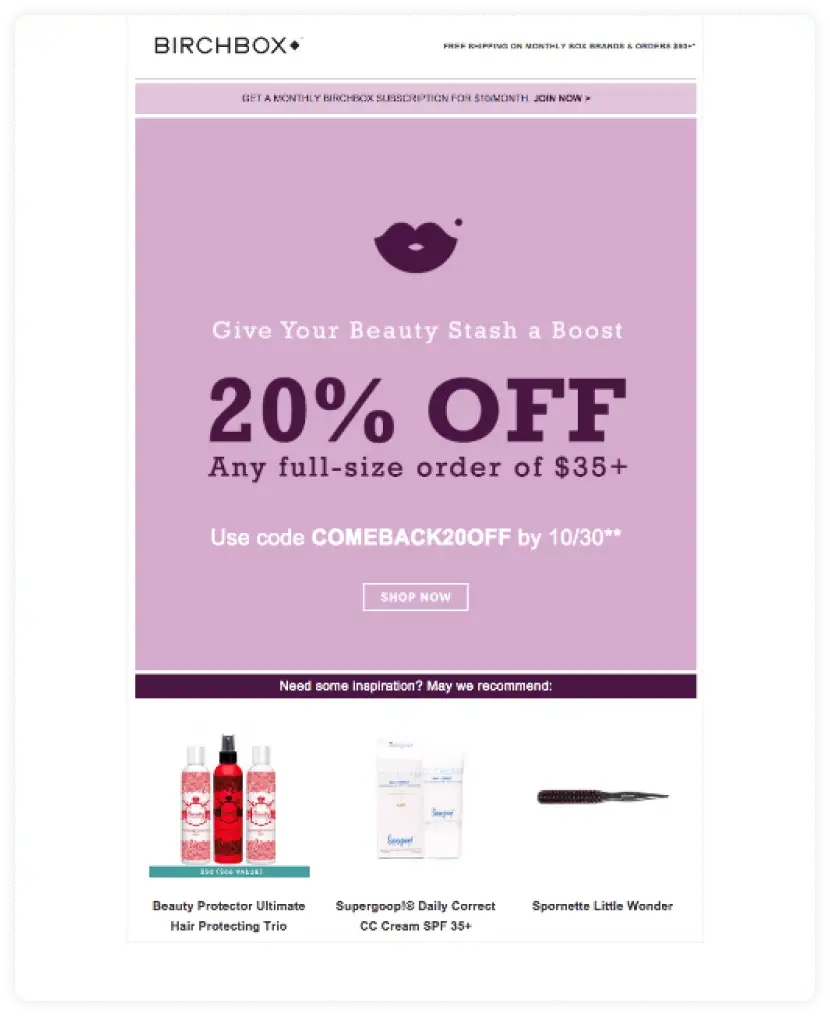

2. Cross-sell nudges
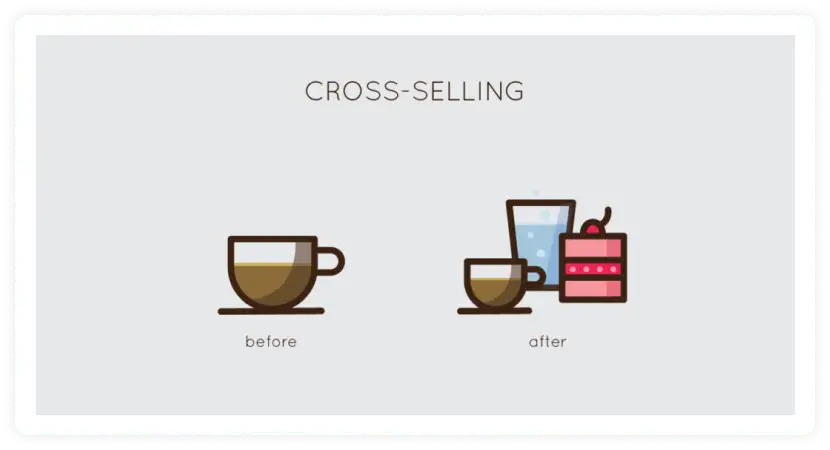
Cross-selling is an art. It's all about predicting what else your customer may be interested in buying based on previous patterns.
In industries like ed-tech, fashion & fin-tech, you can get your customers to transact again using cross-sell nudges. Cross-sell nudges are also prevalent in the beauty industry: if a consumer has purchased a lipstick, you can cross-sell eye-liners and foundation.
The cross-sell nudges should be completely personalized based on the purchased product. Also, the copy tonality and the CTA copy tonality should promote a sense of ease, e.g., Buy in just 60 seconds.
The cross-sell email nudges should also be crafted, considering other nudges like the welcome email series and the time taken to ship the product. If it takes 5-7 days to ship the product and you start cross-selling on day 3 or day 4, it's a very bad customer experience. The customer should have access to the ordered product first and then be nudged to buy something else from your brand.
Few tips for sending the right to cross-sell nudge:
Send the nudge 2-3 days after the average shipping time.
Send the nudges based on the logic - 'customers who bought X also bought Y,' i.e., cross-selling based on the last purchase history.
Have name personalization and create a sense of ease in the copy tonality.
After 2 nudges (I generally have a 2 days' buffer between the 2 nudges), throw in an offer on the product you are cross-selling.
Ideally, the first nudge should be promoting the product you are cross-selling. The second nudge should be a blog-based mailer promoting the cross-selling product. The third nudge should be an email promoting an offer on the product you are cross-selling.
Note: Delay with which you should send the nudges will vary depending on your customer behavior; hence it's recommended that you A/B test the delay of the nudges.
Some examples of cross-selling email nudges:
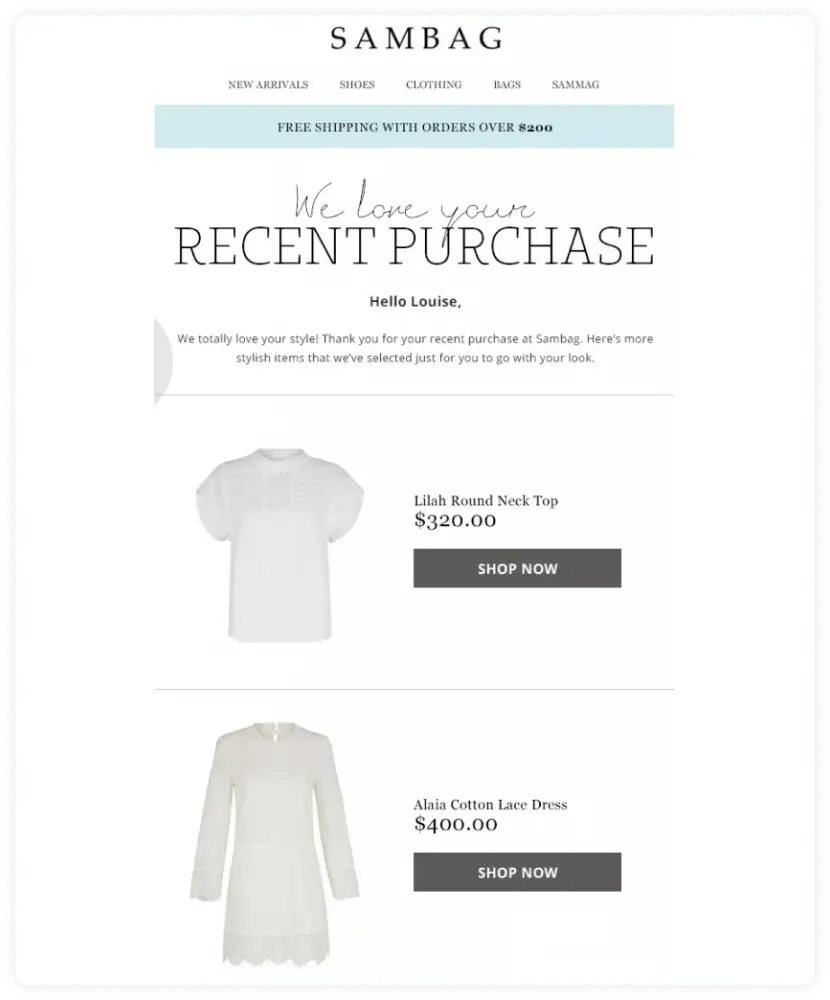

Read also: Product Recommendation Email Series for E-commerce and D2C Brands
3. Refill email nudges
Who doesn't want a refill? But you would want to refill a drink only if you like it. Refill promotes loyalty, and the customers who refill the same product repeatedly start associating your brand with that product. Unlike idle win-back, this automation encourages consumers to refill the same product. Idle win-back encourages idle customers to make the next purchase.
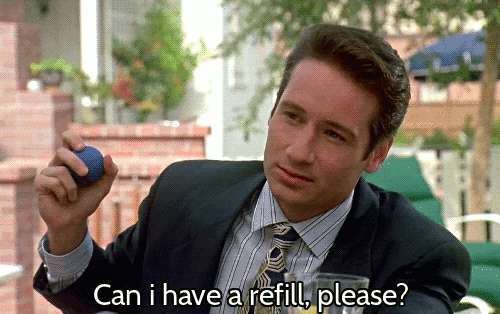
However, while sending refill nudges, 2 very important factors to consider would be:
- The average time to consume your product.
- The feedback/rating given to your product.
Ideally, all refill nudges should be married to a feedback nudge. You don't want users who have given negative feedback to receive the refill nudges-it will lead to unsubscribes or spam complaints. Hence, refill nudges should be sent, suppressing users who have given negative feedback.
An example of a refill nudge is as follows:
- After 21-30 days of purchasing the product, send a feedback nudge.
- If the average consumption period is X, send a nudge to refill on day no. x-5 suppressing users who have given negative feedback.
- Send another nudge on day no. x+1 creating a sense of urgency to the same users. Alternatively, this can be blog content promoting the product.
- Send a final nudge on day no. x+4, this time with a discount on the product. Target the same users.
Note: Delay with which you should send the nudges will vary depending on your customer behavior; hence it's recommended that you A/B test the delay of the nudges.
A few examples of refill nudges are as follows:
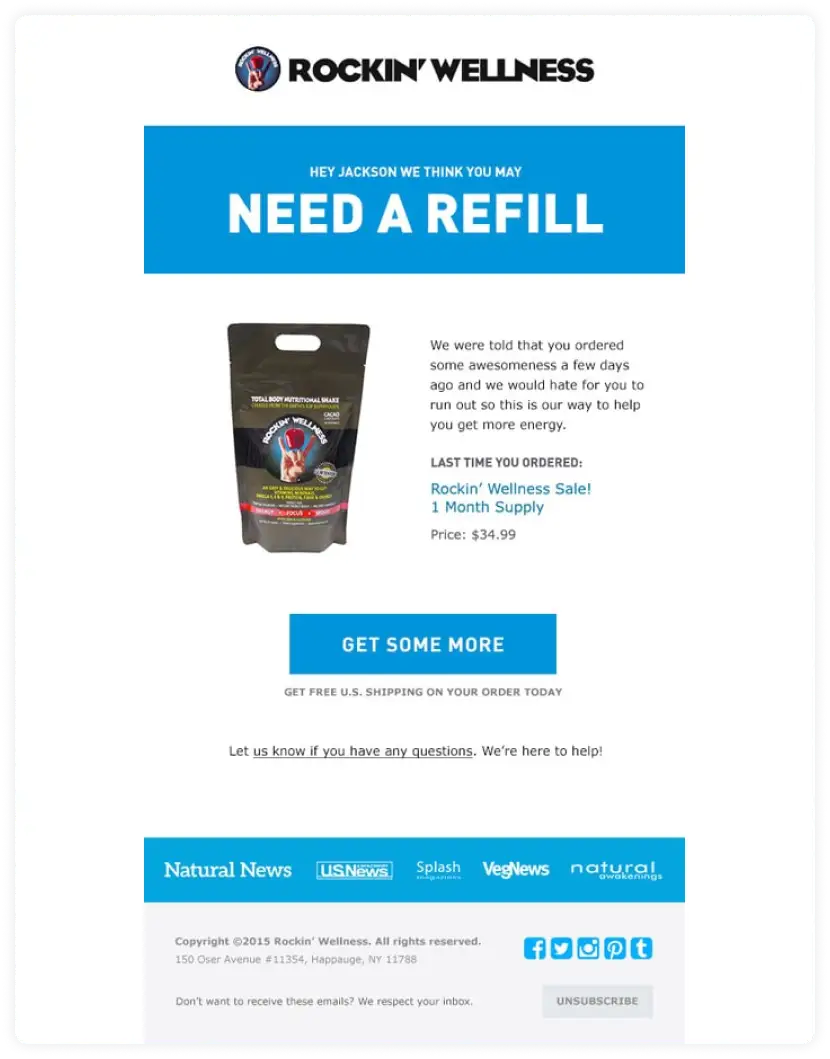
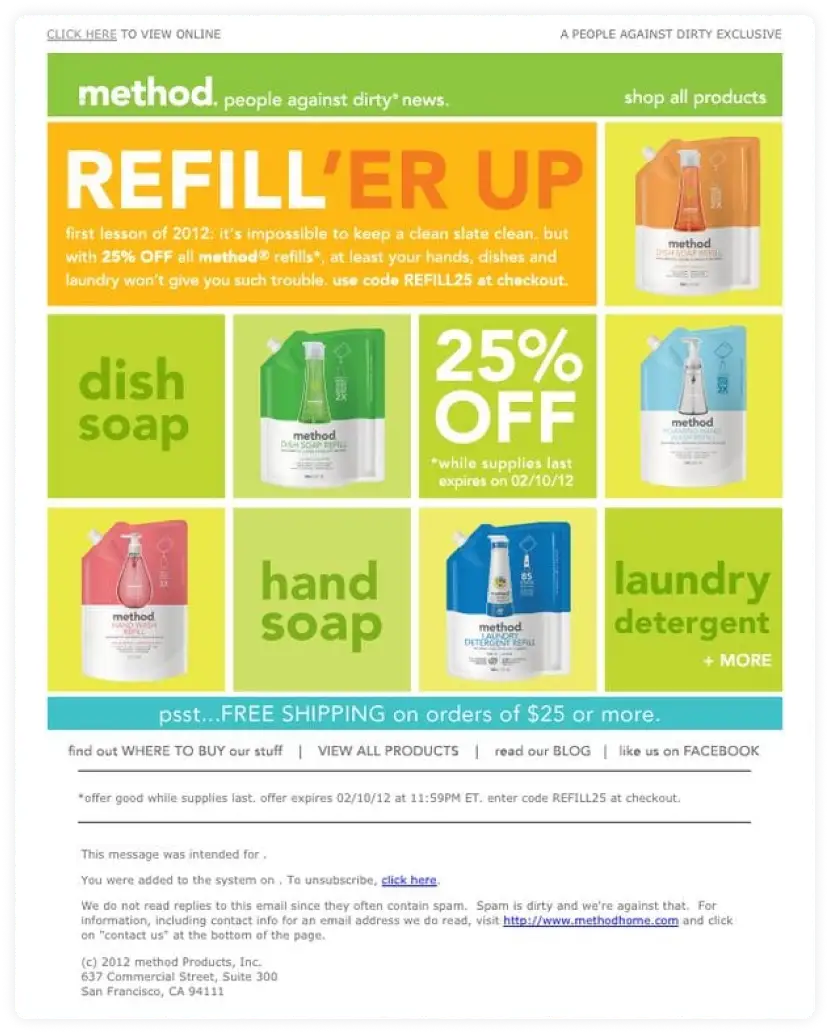
Bonus tip: Use this product refill email automation sequence to increase customer retention and revenue.
4. Gamification campaigns like spin the wheel & interactive campaigns
Gamification is the new trend in email marketing wherein the users are sent plain website offers and encouraged to participate in contests or spin a wheel to get interesting offers.
According to Hubspot, gamified promotions see 40%-50% return user traffic with an Instant Win mechanic, with 3X longer average session duration.
AMP emails are the harbinger of the next era of email marketing! With AMP emails, you can give the users the same experience on the email platform as the website or app. The users can browse products, add to cart, rate products, fill forms, and a lot more! As a result, AMP emails are known to increase the conversion rate by 200%-300%.
One important point to remember while sending such campaigns is that you mustn't target users who have recently transacted unless your industry is food-tech or casual fashion. That's again because of the high repeat transaction tendency in food-tech and casual fashion.
Mailmodo is a one-off product that lets you create AMP emails on the fly with a drag & drop editor containing AMP blocks. Other marketing tools which support the AMP MIME don't have a drag & drop editor, which requires you to hard code the emails, increasing the cost/email.
Some examples of AMP emails and gamified emails are as follows:
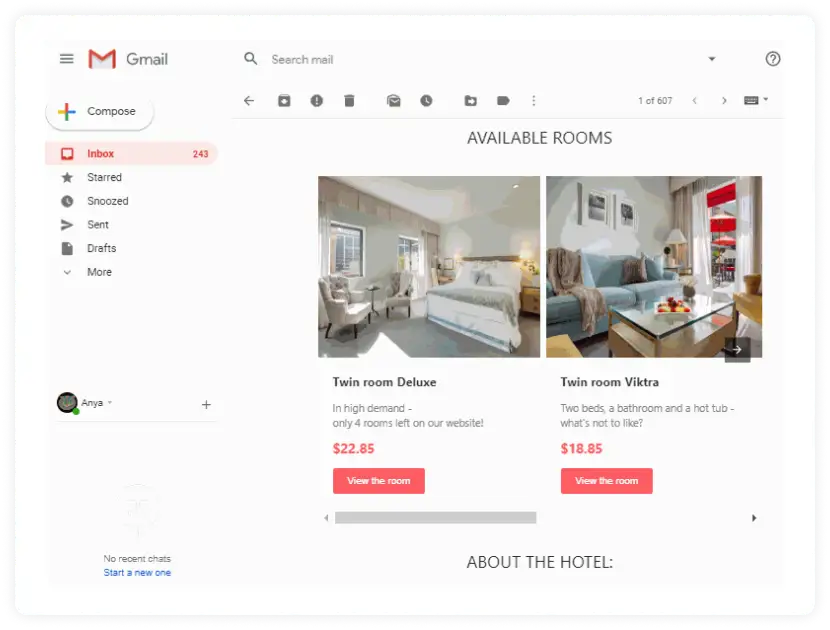

5. Moment marketing campaigns
Moment marketing campaigns are campaigns that sound like topicals. The engagement tends to be higher since the campaigns are related to recent events/social media trends.
Suppressing recent transactors, if you send moment marketing campaigns to the right users at the right time, you can increase your returning customers by 20% plus.
For example, I increased the returning customer rate of a D2C brand by 31% only with 4-moment marketing campaigns.
The moment marketing campaigns should be picked according to what the brand stands for.
For example, World avocado day could be a good marketing theme if it's a professional brand selling hair care products. World engineer's day can be promoted if it's an ed-tech brand. In the food-tech industry, incidents like Neeraj Chopra winning cold or rainy weather can be leveraged as marketing themes.
If you target users from tier 1 cities and most of your users are Gen Z or young millennials, you can have some reel trends in the subject lines, and copies like 'Have you understood the assignment?'
A few examples of moment marketing campaigns are as follows:
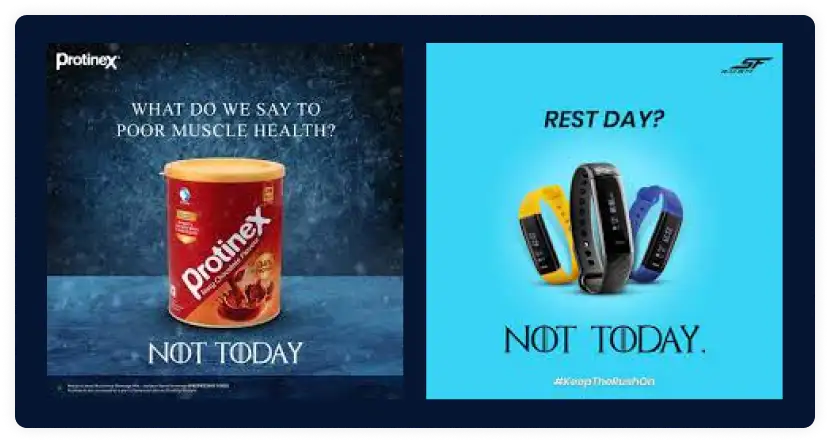
Conclusion
While getting your customers back can be tricky, you can repeatedly make money from your existing customers if you target the right users with the right type of content.
Acquiring customers can be expensive, and your brand must aim at generating the maximum revenue from your brand. The key is to make them feel special to be a part of your brand. The key is to show your customers the velvet rope: the offers they can reap from being loyal to your brand, and your customers will always come back!


